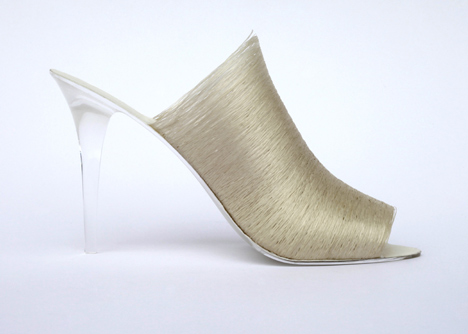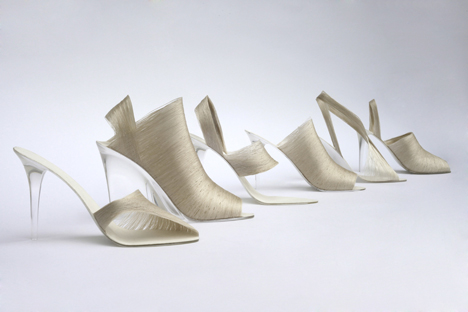Nicole Goymann and Christoph John create shoes from deconstructed silkworm cocoons
Threads of silk resembling strands of hair form the upper of these shoes by German designers Nicole Goymann and Christoph John.

Nicole Goymann and Christoph John wound wet silk threads around a shoe last and used natural silk glue to hold them together as they dried, creating different styles of upper for ladies' footwear.
The designers' Léi Zǔ Shoe Collection was named after the Chinese empress who is attributed with inventing the silk reel.

Goymann and John sourced silkworm cocoons from the area around Hangzhou, China – where they both live – then spun the silk on a wooden reel using an ancient technique.
"The cocoons are purchased from local silkworm farmers around Hangzhou," John told Dezeen. "We then reel the silk by ourselves in the traditional manner with the silk reel – a tool that was invented in China around 2000BC and is still used today."

"The cocoons are softened in boiling water to liquidise the silk glue," explained Goymann. "The silk is reeled directly from the cocoons and wound onto a foot mould and left to dry."
The designers came up with the idea after silk threads kept sticking to Goymann's bobbin while she tried to weave them into a textile.

John then experimented with creating solid forms like dishes and bowls by fusing the threads together using the natural silk glue – sericin.
"I was very surprised how stiff the fibre gets after the surface has completely dried out," said John. "I wanted to explore the limits of my technique and even was able to develop a vase."

The duo started to think up different uses for the technique. "We were thinking of other applications for products," said Goymann. "We could try wrapping the silk thread around a foot and make shoes. First we laughed, then we tried and it worked."

The shoes are currently only decorative pieces, but the pair hopes to turn them into wearable footwear in the near future.
"Nobody dared to try them," said Goymann. "They look just too fragile at this moment. If the shoes can be marketed by the end of next year, we would be very glad. We really want them to be wearable."

The high-heeled shoes have soles made from the bark of a mulberry tree – the plant that provides the main food source for silk works. The heels are moulded in transparent acrylic plastic.

The collection was on show at the Handmade in Hangzhou exhibition alongside other designs created with silk at the Triennale museum in Milan during the city's design week last month.